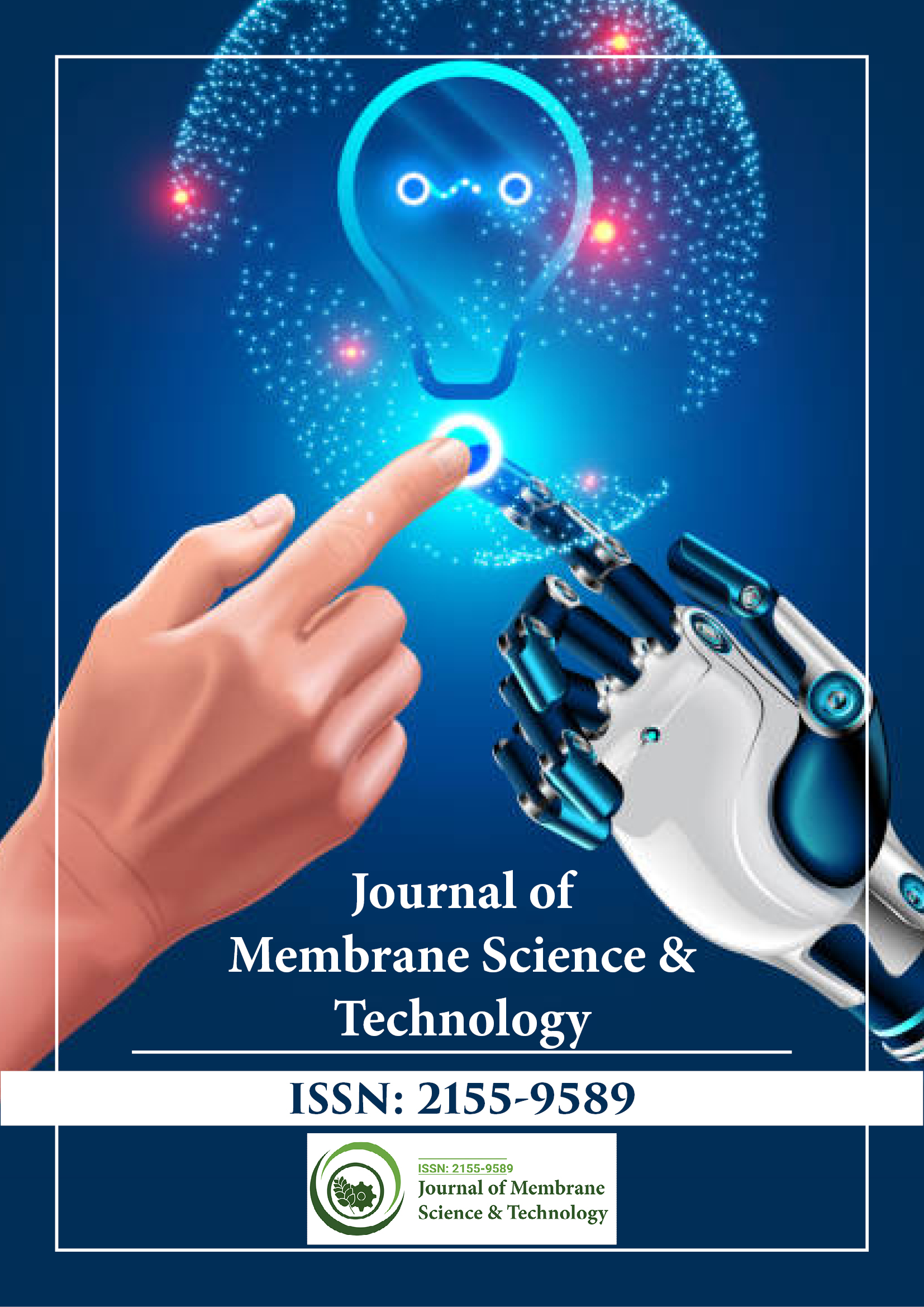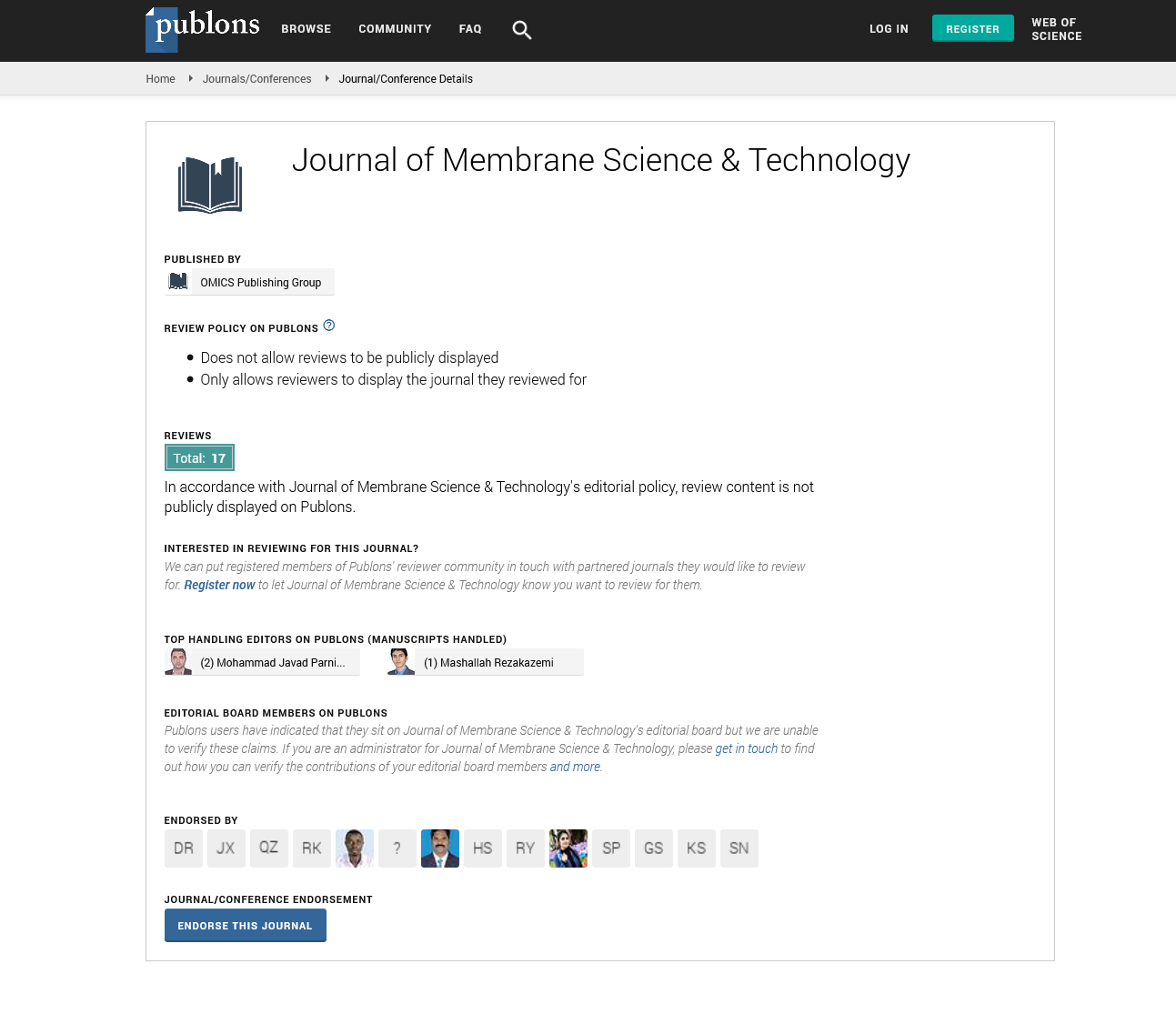Indexed In
- Open J Gate
- Genamics JournalSeek
- Ulrich's Periodicals Directory
- RefSeek
- Directory of Research Journal Indexing (DRJI)
- Hamdard University
- EBSCO A-Z
- OCLC- WorldCat
- Proquest Summons
- Scholarsteer
- Publons
- Geneva Foundation for Medical Education and Research
- Euro Pub
- Google Scholar
Useful Links
Share This Page
Journal Flyer

Open Access Journals
- Agri and Aquaculture
- Biochemistry
- Bioinformatics & Systems Biology
- Business & Management
- Chemistry
- Clinical Sciences
- Engineering
- Food & Nutrition
- General Science
- Genetics & Molecular Biology
- Immunology & Microbiology
- Medical Sciences
- Neuroscience & Psychology
- Nursing & Health Care
- Pharmaceutical Sciences
Perspective - (2025) Volume 15, Issue 1
Membrane Permeability: Mechanisms, Factors, and Applications in Biological and Industrial Systems
Chun Hong*Received: 31-Jan-2025, Manuscript No. JMST-25-29279; Editor assigned: 03-Feb-2025, Pre QC No. JMST-25-29279 (PQ); Reviewed: 17-Feb-2025, QC No. JMST-25-29279; Revised: 24-Feb-2025, Manuscript No. JMST-25-29279 (R); Published: 03-Mar-2025, DOI: 10.35248/2155-9589.25.15.415
Description
Membrane permeability refers to the ability of a membrane to allow certain substances such as gases, liquids or solutes to pass through it while restricting others. This fundamental property plays a crucial role in both biological systems and industrial applications. In living organisms, membrane permeability governs the movement of materials into and out of cells, ensuring internal stability and regulation of critical processes such as nutrient uptake, waste removal and signal transmission. In industrial settings, it determines the efficiency and effectiveness of processes like filtration, separation and purification, making it a key factor in sectors ranging from water treatment to pharmaceutical manufacturing.
Membranes can be broadly categorized based on their structure and intended function. Biological membranes, found in all living cells, consist primarily of a lipid bilayer interspersed with proteins. These membranes exhibit selective permeability, allowing essential molecules such as oxygen, glucose and ions to pass through while excluding potentially harmful substances. Synthetic membranes, on the other hand, are engineered to perform specific tasks and are widely used in various industries. These may be composed of polymers, ceramics or advanced nanomaterials, each offering distinct permeability characteristics tailored to particular environmental conditions or performance requirements.
The movement of substances across membranes occurs through a variety of mechanisms. Passive transport includes diffusion, facilitated diffusion and osmosis. Diffusion involves the movement of small, nonpolar molecules such as oxygen and carbon dioxide across the membrane without the need for energy. Facilitated diffusion, on the other hand, requires the assistance of specific channel or carrier proteins to transport larger or polar molecules like glucose or ions. Osmosis refers to the movement of water molecules across a selectively permeable membrane, driven by differences in solute concentration on either side. In contrast, active transport requires energy, often derived from ATP, to move substances against their concentration gradients. Examples of active transport in biological systems include the sodium-potassium pump, which maintains electrochemical gradients across cell membranes, and processes such as endocytosis and exocytosis, which handle the bulk movement of larger materials.
Several factors influence membrane permeability. The composition of the membrane itself plays a critical role. Membranes rich in unsaturated lipids are generally more fluid and permeable, while the presence of cholesterol in animal cell membranes adds stability and modulates fluidity. The proportion and function of embedded proteins also affect what can pass through the membrane and how easily. Temperature is another important factor; as temperature rises, membrane fluidity increases, which can enhance permeability. However, excessive heat may damage the membrane structure, reducing its effectiveness. The size and polarity of solutes also determine how easily they can cross a membrane small, nonpolar molecules pass more readily than larger or charged ones. Additionally, environmental conditions such as pH and ionic strength can influence membrane properties and the behavior of transport proteins, further impacting permeability. In industrial applications, external pressure can be applied to force substances through membranes, as seen in techniques like reverse osmosis.
Measuring membrane permeability involves various techniques depending on the context and the substances involved. Permeability coefficients are used to quantify the rate at which specific molecules traverse the membrane. Tracer studies utilize labeled compounds to track movement across the membrane, while methods like electrical conductivity measurements and dye uptake assays provide insights into ion transport and membrane integrity. These approaches are vital in both basic biological research and in evaluating the performance of synthetic membranes under operational stress.
In biological systems, the selective permeability of cell membranes is essential for maintaining homeostasis. Cells rely on this property to control internal conditions, manage the uptake of nutrients and expel waste products. Permeability varies across different types of cells and even within cellular compartments. For instance, the blood-brain barrier is known for its extremely low permeability, serving to protect the brain from harmful substances in the bloodstream. Similarly, kidney tubules exhibit finely tuned permeability to regulate water and solute reabsorption during urine formation. These specialized functions highlight how dynamic and vital membrane permeability is to organismal health and function.
In industrial contexts, understanding and manipulating membrane permeability allows for the design of processes that meet specific performance criteria. In water treatment, for example, membranes are employed in ultrafiltration, Nano filtration and reverse osmosis to remove contaminants and produce clean water. In the pharmaceutical industry, membrane permeability is central to drug delivery systems, determining the rate and location of therapeutic release within the body. Food processing applications benefit from membrane technologies that help concentrate juices, filter dairy products or isolate valuable bioactive compounds. In gas separation, membranes are used to selectively allow the passage of certain gases, such as oxygen or nitrogen, improving energy efficiency and product quality.
The field of membrane engineering is rapidly advancing thanks to breakthroughs in materials science and nanotechnology. Researchers are developing graphene-based membranes that offer unprecedented permeability and selectivity due to their atomic-scale structure. Stimuli-responsive membranes are being designed to alter their permeability in response to environmental cues such as pH, temperature, or light. Bio-inspired designs are mimicking natural systems, such as aquaporins, to achieve efficient and selective water transport. Additionally, 3D printing technologies are enabling the creation of customizable membrane structures that can be tailored for specific filtration or separation needs. These innovations are poised to revolutionize how membranes are used, making processes more efficient, cost-effective and sustainable.
Membrane permeability remains a cornerstone of both biological science and industrial engineering. From regulating the internal environment of cells to purifying drinking water on a large scale, it enables critical functions across many domains. As global challenges such as water scarcity, pollution and health care demand more efficient and adaptive technologies, a deeper understanding and better control of membrane permeability will be essential. With ongoing research and development, this vital property will continue to be a key driver of progress in science, medicine and industry.
Conclusion
Membrane permeability remains a cornerstone of both biological science and industrial engineering. From regulating the internal environment of cells to purifying drinking water on a large scale, it enables critical functions across many domains. As global challenges such as water scarcity, pollution and health care demand more efficient and adaptive technologies, a deeper understanding and better control of membrane permeability will be essential. With ongoing research and development, this vital property will continue to be a key driver of progress in science, medicine and industry.
Citation: Hong C (2025). Membrane Permeability: Mechanisms, Factors, and Applications in Biological and Industrial Systems. J Membr Sci Technol. 15:415.
Copyright: © 2025 Hong C. This is an open-access article distributed under the terms of the Creative Commons Attribution License, which permits unrestricted use, distribution, and reproduction in any medium, provided the original author and source are credited.

